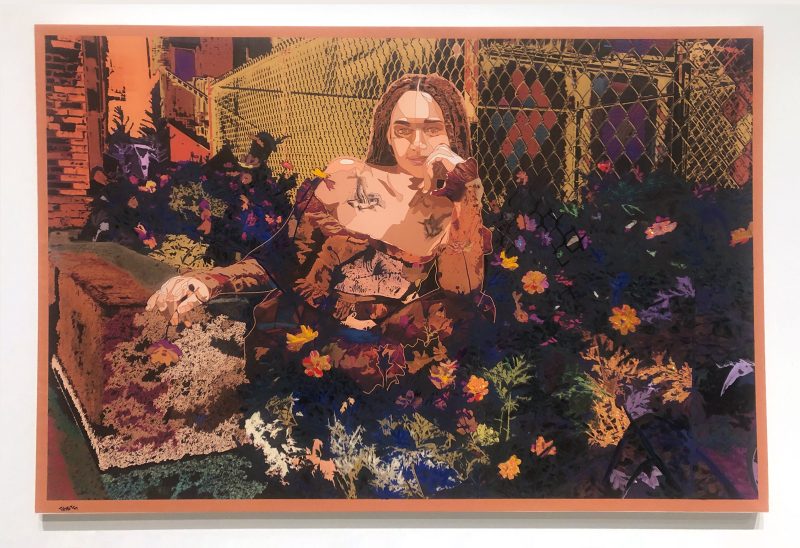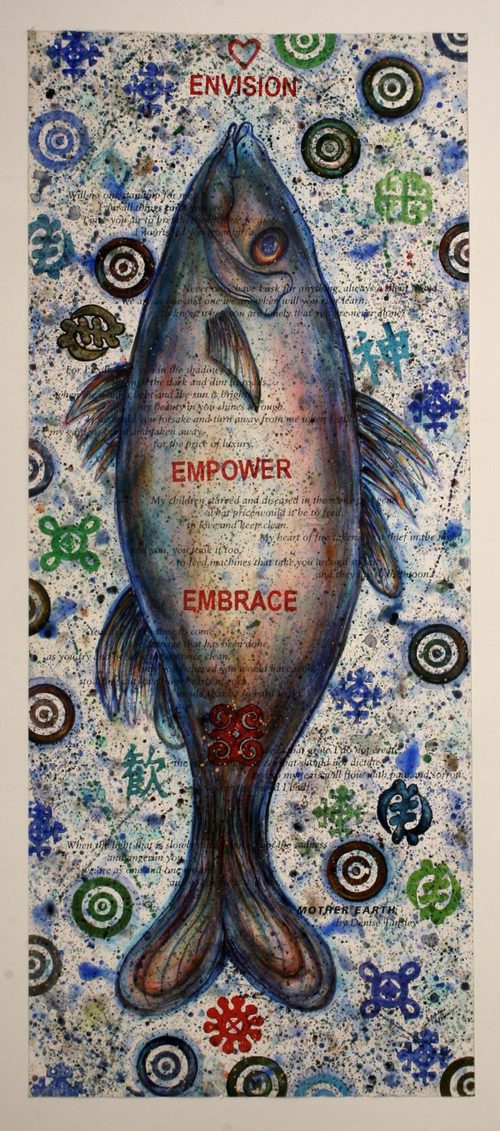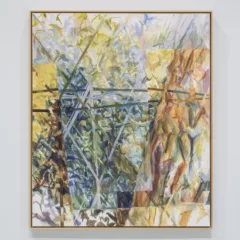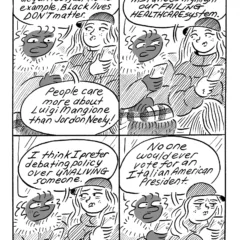
Intergenerational Legacy
Historically, the Western art canon has erased and overlooked the contributions of Black artists working in the collage medium. This is unfortunate when considering that White Cubist artists such as Georges Braque and Pablo Picasso were inspired by African tribal art during the upheaval of the industrial revolution. Today, Black collage artists are responding to contemporary issues around systemic racism in distinctive and expansive ways. Ben Jones and Amani Lewis’s recent solo shows at the August Wilson African American Cultural Center showcase the intergenerational legacy of Black collage artists, while also elevating the Black experience through the medium. These multifaceted artists are not wedded to prescriptive depictions of Black figuration, they go beyond the script of the academy’s expectations for artists to master formal skills, the pair invoke their identities while displaying innovation within the medium. Thoughtfully layered works reveal deeply interpersonal convictions that intersect the canvas while at the same time moving the viewer to contemplate their own individual relationships with the subject matter. In so doing, the artists effectively communicate that they are working as artists within a politicized society, still while providing a beautiful visual intervention displaying the complexity of the Black experience.
Jones’ artistic practice spans some fifty years dating back to the Black Arts Movement — while the work of Lewis — a talented emerging artist – explores Black humanity in Baltimore during the initial period of Black Lives Matter, as defined by the 2015 Freddie Gray incident. During their panel discussion with Kilolo Luckett — Curator of Visual Arts, The August Wilson African American Cultural Center — both artists convincingly affirmed their right to access and expand the Western narrative. Challenging discrimination and power in all its various forms requires artists with different perspective to draw us closer to unconventional truths. Together, Jones and Lewis invoked the Black radical tradition of activism as it continues with the intergenerational legacy of collage practice, all while working to establish the museum as a site of protest to decolonize the Western gaze.
Romare Bearden’s Influence
Although, Jones and Lewis are at different stages in their respective careers — both cited Romare Bearden’s work in collage art as an important source of inspiration for their own artistic practice and vision. Works such as “Black Venus,” 1968 afforded Bearden creative freedom from the constraints of figuration while simultaneously reconstructing a counternarrative of Black subjectivity during the Civil Rights era. Whereas, later Jones’ work draws from the Black Arts movement, socialist theory, African spirituality and the dance of the Black diaspora. While on the other hand, Lewis’s “millennial collage” is inspired by her era’s cohort, thereby intimately portraying the Black millennial generation’s story in the age of social media. Black collage practice provides each artist with a framework to further interpret and interrogate Black life through the same process Bearden used – layering. Tracing their work back to Bearden provides evidence of a larger historical lineage for each to be situated within, which in turn makes their own voices more legible. Nevertheless, despite both Jones and Lewis’s activist stances in their work, each makes distinct artistic choices leading to some interesting departures.

Resurgence – Rise Again
Ben Jones’ solo show Resurgence – Rise Again featured eight large-scale works that aimed to bring attention to the “plight and ascension of humankind.” Resurgence is meant to catalyze young people into action against ecological disaster, racism, and late stage capitalism. Jones work is multifaceted, layered in texts, bold imagery, and references to Africa. Jones said that the “arts play a very important role” in how we find solutions to heal the planet and human kind. Jones’ socialist activism and political voice are loudly communicated in pieces such as “Envision, Empower, Embrace,” 2010 and “Destruction Wall Paper,” 2017. The influence of Jones’ 50-plus cultural visits to Cuba since the 1970s are seen throughout his critical oeuvre.
“His work brings critical attention to the struggle for civil rights, social justice, and equality in education, and the destruction of the environment, yet they also radiate beauty, inspiration, and power” said Luckett as mentioned in her curatorial statement from “Resurgence, Rise Again, the Art of Ben Jones.”
When viewing Jones’ work the cultivated eye is able to discern that this is not the work of mere formalism, but an active visual protest calling for collective action against capitalism and the destructive forces of racism affecting our globalized world today.
Subjective Nature
Amani Lewis’s Subjective Nature is her first solo show. Lewis graduated in 2016 from the Maryland Institute College of Art with a BFA in General Fine Arts and Illustration. Amani says growing up in Columbia, Maryland and later attending the Maryland Institute College of Art in Baltimore has had a profound influence on her working lenses and practice. An excerpt from Lewis’s artist statement said in regards to stereotypes around Blackness: “I am constantly challenging these perceptions, and digging into the root causes by asking questions such as: How have these issues been ignored over time? What can we do to change these realities?”
Lewis’s “12 O’Clock Boyz,” 2018 provides an opening for the viewer to look beyond statistics and the media to contemplate the subjectivity of millennial-aged Black people in more contemporary terms. While figuration is prominent in Lewis’s “Negroes in the Trees” series, there are also bends towards Norman Lewis’s abstract political work. They express in their work broader contemplations of Black subjectivity, thereby wrestling not only with race, but also the gender binary itself – such as in “12 O’Clock Boyz” where sexuality is obscured as you can see in the lower half of the collage.
“You have this older generation with this younger generation, and … there is this connection, these foundations that Ben has really built, that Amani then uses that as a springboard for the foundation of their work,” said Luckett as said in Pittsburgh’s NPR News Station.
Intersecting PostBlack
Jones’ longevity and Lewis’s recent coming into view represent a radical stance in collage practice in that they both further establishes a distinct visual iconography describing Black subjectivity in the canon. Jones and Lewis are not running from their Blackness, instead their individual identities affords them with a unique opportunity to personalize their creativity to help us understand the diversity of our world and the interconnectedness of humanity.
About the writer: Kemuel Benyehudah is a doctoral candidate at the University of Pennsylvania. His interests lie in education, representation, and history. Kemuel is a research associate at the Rutgers Center for Minority Serving Institutions. He is working with the Kislak Center on an exhibition featuring Arthur Tress’s Collection of Japanese illustrated books and prints. He graduated from Hunter College in New York, New York with a bachelor’s degree in sociology, and minor in studio arts.









